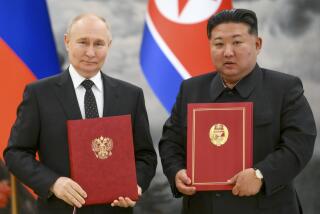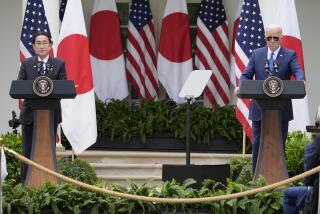Who Is the U.S.-Japan Defense Pact Aimed At?
- Share via
On Sept. 24, the United States and Japan will announce defense guidelines that are supposed to define the military relationship between the two nations well into the next century. Current negotiations about the new Japanese-American military division of labor are the fruit of the 1996 Clinton-Hashimoto summit in Tokyo. The two leaders pretended then to respond to Okinawan protests against U.S. bases while actually committing to an enhanced military alliance that will replace the Japanese-American strategy drawn up 19 years ago against the Soviet Union.
But who is this new alliance aimed at? Pentagon spokesmen claim that North Korea remains a threat, even though it is experiencing a major famine and is no longer supported militarily by Russia or China. North Korea recently broke off talks with the U.S. and South Korea because its ambassador to Egypt defected to the U.S., but the timing of the defection so perfectly suits the goals of the Pentagon that one wonders whether it or the CIA did not play a decisive role.
The obvious target of the new U.S.-Japan military alliance is China, a fact not lost on the Chinese leadership. The People’s Liberation Army newspaper on Aug. 19 pointedly reminded the Japanese that the treaty in which Beijing and Tokyo normalized diplomatic relations specifically stipulates that Taiwan is a part of China. As a result, Prime Minister Ryutaro Hashimoto, who has just paid a visit to Beijing, assured Premier Li Peng that Japan would never support Taiwan’s independence.
In Japan itself, a furor has blown up over its dalliance with the Pentagon. In response to U.S. demands that the Japanese government pay more to keep American troops in Japan, Tokyo on Aug. 4 instead announced plans to cut the 1998 omoiyari yosan (its so-called sympathy budget, meaning sympathy for the poor Americans who cannot afford their foreign policy). By 2001, the Japanese want to terminate their payments altogether, since they face an even more severe national government deficit as a percentage of GNP than does the U.S.
The big issue for Japan, however, is the geographic scope of the new guidelines, an issue that threatens the internal unity of the Liberal Democratic Party. On July 22, Koichi Kato, the secretary-general of the LDP, told U.S. Deputy Secretary of State Thomas Pickering that “the areas surrounding Japan” mentioned in the review of defense guidelines and thereby covered by the U.S.-Japan Security Treaty must not include the Taiwan Strait. A week later, Hitoshi Tanaka, deputy director general of the foreign ministry’s North American Bureau, echoed that position.
Aware that these statements would irritate the Americans, on Aug. 17, Chief Cabinet Secretary Seiroku Kajiyama said, “In case of a Taiwan-China military conflict, how could we flatly refuse a request from U.S. forces for support, even a supply of water?” Chinese Deputy Foreign Minister Tang Jiaxue replied that the Taiwan Strait was “the most important and sensitive issue in Chinese foreign affairs” and demanded a clarification. The formula Hashimoto tried to sell to the Chinese is that in discussing “areas near Japan” to be covered by the new guidelines, Japan had not discussed any specific area such as the Taiwan Strait.
Elsewhere in Asia, Kishore Mahbubani of the Singapore government has argued that, “To avoid provoking China’s ire, the U.S.-Japanese alliance should remain defensive, should not include Taiwan and should not be extended or changed without careful consideration of regional concerns.” Even the normally cooperative South Koreans have asked Japan and the U.S. to consult them and seek their agreement whenever implementing joint defense activities affecting Korea’s sovereign rights.
As Bruce Stokes and James Shinn, directors of a Council on Foreign Relations study of the U.S.-Japan security relationship, pointed out in an August newspaper article: “If war broke out today on the Korean Peninsula or in the Taiwan Strait, the United States could not count on Japan to stand with it in a timely fashion.” Unfortunately, the Stokes-Shinn solution is to demand that Japan increase its military contributions and buy more American-manufactured weapons.
If Americans truly understood what the new guidelines now propose, they would be outraged. According to the draft released in June, “The [Japanese] Self-Defense Forces will conduct such activities as intelligence gathering, surveillance and minesweeping, to protect lives and property and to ensure navigational safety. U.S. forces will conduct operations to restore peace and security in the areas surrounding Japan.” This means that if a threat did arise, American lives would be at risk while the Japanese conducted “intelligence activities.” Meanwhile, Japanese commentators worry that even minesweeping and intelligence activities go well beyond what their “peace constitution” allows.
The real problem is that Japan, the U.S., China and the other Asian nations do not see eye to eye on whom this defense treaty is supposed to defend and under what circumstances. This is why it cannot work in practice and only will increase tensions in the region.
More to Read
Sign up for Essential California
The most important California stories and recommendations in your inbox every morning.
You may occasionally receive promotional content from the Los Angeles Times.













